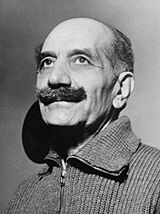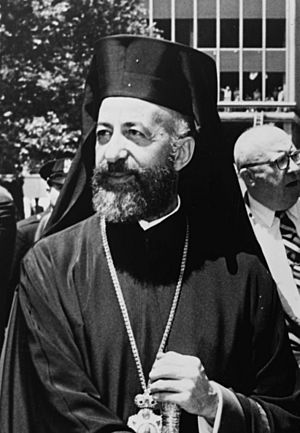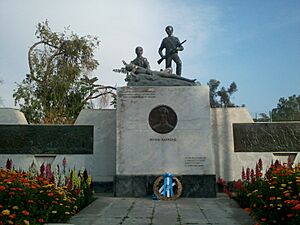EOKA facts for kids
Quick facts for kids EOKAΕθνική Οργάνωσις Κυπρίων Αγωνιστών National Organisation of Cypriot Fighters |
|
|---|---|
| Active | 1955–1959 |
| Ideology | Enosis Greek nationalism Anti-imperialism Anti-British sentiment Anti-communism Religious conservatism |
| Political position | Right-wing |
| Leaders | George Grivas Grigoris Afxentiou |
| Headquarters | |
| Succeeded by | |
| Allies | |
| Opponents | AKEL Black Gang 9 September Front |
| Battles and wars | Cyprus Emergency |
EOKA (a name that stands for National Organisation of Cypriot Fighters in Greek) was a Greek Cypriot nationalist group. From 1955 to 1959, it fought a campaign to end British rule over the island of Cyprus. The group's main goal was enosis, which means the union of Cyprus with Greece.
Contents
Why the Conflict Started

The island of Cyprus is in the Mediterranean Sea. For centuries, most of its people have been ethnically Greek. In 1571, the Ottoman Empire took control of the island. In 1878, the Ottomans handed control of Cyprus to the British Empire.
Many Greek Cypriots hoped that Britain would unite Cyprus with Greece. This idea, called Enosis, was very popular. They were hopeful because Britain had given other Greek-speaking islands to Greece before. However, Britain did not do this for Cyprus.
Over time, many Greek Cypriots grew unhappy with British rule. They felt that Britain was not investing in the island and that their goal of Enosis was being ignored. At the same time, the Turkish community on the island began to develop its own sense of nationalism and was strongly against Enosis.
In 1931, frustration boiled over. Greek Cypriots protested against new taxes and British rule. This led to a big riot in the capital city, Nicosia, which became known as the October Events. After the riot, the British government banned protests and political activity related to Enosis. This period of strict rule lasted until World War II.
By the 1950s, many Greek Cypriots felt that peaceful methods were not working. They decided a military campaign was needed to achieve their goal.
How EOKA Was Formed
EOKA was created to fight for the independence of Cyprus from Britain and its union with Greece.
EOKA's Leaders and Goals
The military leader of EOKA was Georgios Grivas, a Greek army officer. He used the secret name Digenis, after a hero from old Byzantine legends. The political leader was Archbishop Makarios III, the head of the Cypriot Orthodox Church.
Grivas and Makarios had a clear goal: to make British rule so difficult that Britain would decide to leave Cyprus. They planned to do this through attacks that would get attention from around the world. They hoped this would put pressure on Britain to grant Cyprus Enosis.
Getting Ready to Fight
Grivas arrived in Cyprus in late 1954 to set up his secret network. He recruited young people from farmers' unions and youth groups. EOKA had two main parts:
- Mountain groups: These were fighters who lived in hidden camps in the forests and mountains.
- Town groups: These were members who lived normal lives in cities but carried out secret missions.
A larger network of supporters, called the National Front of Cyprus (EMAK), helped EOKA with supplies, information, and safe houses.
The Armed Campaign
EOKA's fight began on the night of April 1, 1955. The group set off bombs across the island, attacking police stations and military sites. Grivas announced the start of the campaign with a message signed "Digenis." He ordered his fighters to only attack British soldiers and Greek Cypriots who were helping them.
The British were surprised by the attacks. They brought more soldiers to Cyprus from Egypt to increase security.
British and Turkish Reactions
The British tried to stop EOKA in several ways. They brought in a new governor, Sir John Harding, who declared a State of Emergency. This gave the authorities more power, including the use of the death penalty for serious crimes. The British also hired more Turkish Cypriots to join the police force. This created tension between the Greek and Turkish communities.
The government of Turkey and the Turkish Cypriots were strongly against Enosis. They worried that if Cyprus joined Greece, the Turkish minority would be mistreated. In response, Turkish Cypriots formed their own armed groups, most notably the TMT.
The Fight Escalates
In March 1956, the British exiled Archbishop Makarios to the Seychelles, an island nation in the Indian Ocean. They hoped this would weaken the EOKA movement. Instead, it made Greek Cypriots angrier and led to more attacks.
EOKA's campaign became more intense. Fighters ambushed soldiers, bombed buildings, and organized riots. Young people, including schoolchildren, played a big role in the protests. The British forces conducted large-scale search operations, but they struggled to find EOKA's hidden fighters and weapons.
During this time, there were claims that British forces used harsh methods and torture when questioning suspects. These claims were used by EOKA for propaganda and caused political problems in Britain.
Violence Between Communities
At first, EOKA avoided attacking Turkish Cypriots. But as the conflict went on, Grivas began to target Turkish Cypriot police officers. This led to fighting between the Greek and Turkish communities in the summer of 1958. Both sides attacked each other, and many people were killed. The violence showed how deeply the two communities were divided.
The End of the Conflict
By the end of 1958, all sides were ready for a compromise.
- The Greek Cypriots feared that the ongoing violence would lead to the island being partitioned, or split in two.
- Greece and Turkey worried that the conflict could lead to a war between them.
- Britain wanted to find a peaceful solution and stop the fighting.
In 1959, leaders from Britain, Greece, and Turkey, along with representatives of the Greek and Turkish Cypriots, met in Switzerland and London. They signed the London-Zürich Agreements.
The agreement stated that Cyprus would not join Greece or be partitioned. Instead, it would become an independent country. Grivas and Makarios accepted the deal, and the EOKA campaign officially ended on March 9, 1959.
During its four-year campaign, EOKA's actions led to the deaths of over 100 British soldiers, 54 police officers, and 238 civilians.
After the Fighting
After the agreement, Cyprus became the Republic of Cyprus in 1960. Archbishop Makarios became its first president. Many EOKA members were given jobs in the new government.
However, the problems between the Greek and Turkish communities did not go away. Both sides still had different goals, and tensions eventually led to more conflict in the 1960s and 1970s.
Legacy and Memory
Today, Greek Cypriots see the EOKA fighters as heroes who fought for freedom. April 1, the day the campaign began, is a national holiday in Cyprus. There are many monuments and a museum in Nicosia dedicated to the EOKA struggle.
Part of the old central jail in Nicosia, where some EOKA members were held and executed by the British, is now a museum. It honors the memory of those who died in the fight.
See also
- EOKA B
- Grigoris Afxentiou
- Evagoras Pallikarides
- Markos Drakos
- Michalis Karaolis
- Nikos Sampson
- Battle of Spilia




